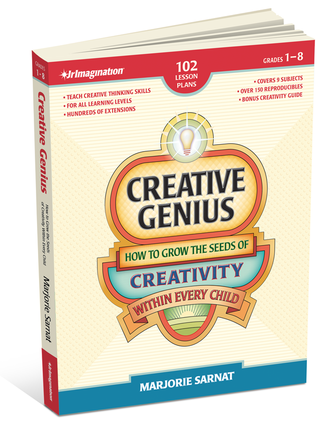Creative Genius: It Takes Both Sides
 Friday, September 30, 2011 at 8:31AM |
Friday, September 30, 2011 at 8:31AM |  Marjorie Sarnat
Marjorie Sarnat 
What is Creativity? Creativity is about problem solving in a new way. It is using skills to generate ideas and bring about something unique and valuable. Although the creative process involves imagination and self expression, it must be purposeful in reaching “outside the box” to solve a problem, meet a need, or accomplish a goal.
Although some children are innately more creatively inclined, all kids can learn creative thinking skills and get in the habit of using them for problem solving in life, work, and play.
Divergent And Convergent Thinking
We often hear the terms “right brain” and “left brain” thinking. This refers to the two hemispheres of the brain, each of which dominate different thought processes. In reality, both hemispheres need to work together for us to do anything meaningful.
As a broad generality, “right brain” (the right hemisphere) controls the more divergent style of thinking, and “left brain” (the left hemisphere) controls the more convergent style of thinking.
Divergent Thinking: Diversify and explore.
Creative thinkers use divergent thinking to generate new ideas. In divergent thinking you start with an idea or information and move outward from it, looking at related ideas or things, and going wherever thoughts lead. This style of thinking resists closure and seeks to explore options, new connections, and possibilities. This style of thinking is freely open to anything and everything.
Convergent Thinking: Choose and refine.
The convergent style of thinking selects ideas or information and focuses to eliminate the extraneous by filtering and refining information. Convergent thinking leads to a specific point. The convergent approach holds ideas up to scrutiny by determined standards. Convergent thinking seeks closure and definitive answers, and screens out that which does not lead toward your goal.
Both divergent and convergent thinking are essential for generating successful ideas.
This interplay of the two thinking styles results in innovations that are unique and have value. The two thinking styles do not take place simultaneously; they alternate. For example, use divergent thinking to explore many possibilities. Use convergent thinking to determine the best possibility. Use divergent thinking again to generate ideas for making a possibility more useful. Use convergent thinking again to refine those ideas.
As creative thinkers move back and forth between the two styles, they’re not necessarily conscious of which style they are using. They continue until they generate a valuable, groundbreaking idea.
Creativity in the Classroom
Our children often practice a convergent style of thinking in school, but they need more opportunities to exercise divergence, as well. Our Creative Genius lesson plans strengthen divergent thinking skills along with convergent thinking skills. They’re great fun and anyone can use them.
Go over to our Freebies page and download these free lesson plans: “What Can You Do With a Paper Clip?” and “What Can’t You Do With a Paper Clip?” And let us know your thoughts in the comments.
 children,
children,  convergent,
convergent,  creative thinking,
creative thinking,  creativity,
creativity,  divergent,
divergent,  left brain,
left brain,  right brain
right brain 


